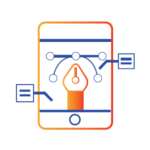AUTO LEVEL
A dumpy level, builder’s auto level, levelling instrument, or automatic level is an optical instrument used to establish or verify points in the same horizontal plane. It is used in surveying and building with a vertical staff to measure height differences and to transfer, measure and set heights.
Applications
The level instrument is set up on a tripod and, depending on the type, either roughly or accurately set to a levelled condition using foot screws (levelling screws). The operator looks through the eyepiece of the telescope while an assistant holds a tape measure or graduated staff vertical at the point under measurement. The instrument and staff are used to gather and/or transfer elevations (levels) during site surveys or building construction. Measurement generally starts from a benchmark with known height determined by a previous survey, or an arbitrary point with an assumed height.
Course Highlights:
- OVERVIEW OF AUTOLEVEL
- WHAT IS LEVELLING
- TYPES OF SURVEYER APPRATUS
- IMP EQUIPMENT WHEN USING AUTOLEVEL
- SOME IMAGES
Technical Feature
Parts:
An auto level consists of a telescope with various screws to adjust the line of sight. A tripod is also used to mount and adjust the auto level.
An Automatic Level
Telescope:
It holds the lenses that magnify objects in the sight.
Objective Lens:
It catches the object being sighted and magnifies the object.
Eyepiece:
It is located at the viewing end of the telescope, it can be turned to bring the crosshairs into focus.
Focusing Knob:
It can be turned to make objects appear crisp and clear.
Leveling Screws:
It allows adjustments to be made to ensure the instrument is level.
Base Plate:
It is the area to which the automatic level attaches on the tripod.
Horizontal Tangent Screw:
It can be adjusted to make the instrument move left or right on the horizontal plate. It is also known as ‘slow motion knobs’.
Circular Level:
It is mounted on the automatic level, it ensures that the instrument is at a true level point.
A Circular Level Tripod:
A tripod is a three-legged stand, important in providing the foundation for auto levels and other levelling instruments. It is usually made up of Aluminum for the sake of lightness.
Crosshairs:
It is a diaphragm consisting of horizontal hair and vertical hair fitted in the Telescopic Tube of the Level. Staff is bisected at the intersection of the crosshairs to take the reading.
Crosshair
Levelling is a process of determining the height of one level relative to another. It is used in surveying to establish the elevation of a point relative to a datum, or to establish a point at a given elevation relative to a datum.
The main instruments used for levelling include:
- Dumpy level: Often a generic term for an optical level.
- Tilting level: Replaced by the automatic level but useful where vibrations a problem.
- Automatic level: Includes an internal pendulum which allows a horizontal reading.
- Laser level.
- Digital level: Staff read automatically.
- Water level: Useful in confined spaces.
Auto Level Setup
1. Setup your tripod as level as possible, step on tripod legs to drive into the ground.
2. Attach auto level to the tripod.
3. Adjust level so bubble is cantered in vial.
4. Adjust recital until crosshairs are clear.
5. Adjust the objective lens until object you are sighting on is clear.
Care of Auto Levels
If the instrument becomes wet leave it unpacked. Wipe down instrument, clean and dry transport case. Pack up instrument only when it is perfectly dry. Never touch the glass with fingers, use soft clean lint-free cloth to clean lens.
Checking Auto Level Accuracy
1. Set up instrument in an area that is as level as possible and which is about 220 feet long. Place two matching level rods or two pieces of strapping in the ground about 200 feet apart with the faces toward each other. Position and level the instrument so that the distance from the instrument to each rod is the same measure.
2. Take a reading on each rod with the instrument (or mark each piece of strapping where the crosshair is sighted).
3. Move transit to another spot on the line and take readings and mark both rods again.
4. The difference between the marks on the rod will be the error of the instrument. The error needs to be corrected by a competent repair technician.











